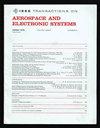复杂变化环境下IMU和可见光集成定位的鲁棒数据模型双驱动融合
IF 5.7
2区 计算机科学
Q1 ENGINEERING, AEROSPACE
IEEE Transactions on Aerospace and Electronic Systems
Pub Date : 2025-03-26
DOI:10.1109/TAES.2025.3550904
引用次数: 0
摘要
可见光定位(VLP)以其广泛的基础设施、低能耗和高精度而备受关注。然而,现有的VLP方法往往难以对环境和接收器状态的变化做出快速响应,并且在整个执行过程中都有固定的参数。这种限制阻碍了它们自适应调整系统模型参数的能力。在本文中,我们提出了一种鲁棒数据模型双驱动的VLP和惯性导航紧密耦合集成方法,并结合不确定性估计,以充分发挥数据驱动和模型驱动方法的互补优势。我们开发了一个数据驱动的特征编码器,该编码器由来自变压器的VLP双向编码器表示(VLP- bert)和VLP图注意网络(VLP- gat)组成,使系统能够在不断变化的环境中检测异常观测。VLP-BERT用于有效编码可见光信号特征,而VLP-GAT用于编码信号特征与锚点空间构型之间的相关特征。然后将这些编码特征解码为距离置信度。随后,数据驱动的结果被合并到一个紧密耦合的集成模型中,允许对系统参数进行自适应调整。此外,接收器不可避免地会受到遮挡和轻微倾斜的影响。为了解决这些问题,我们实现了基于信号变化特征的遮挡检测和错误检测策略。我们进一步利用紧耦合集成模型中的系统状态来排除低精度观测并求解VLP中的接收机标题。为了验证所提出的导航器以及VLP-BERT和VLP-GAT的有效性,进行了大量的实验。与现有方法相比,该导航器在复杂多变的环境中实现了精确、鲁棒的导航。本文章由计算机程序翻译,如有差异,请以英文原文为准。
A Robust Data-Model Dual-Drive Fusion for IMU and Visible Light Integrated Localization in Complex Changing Environments
Visible light positioning (VLP) has attracted considerable attention due to its widespread infrastructure, low energy consumption, and high precision. However, existing VLP methods often struggle to respond promptly to environment and receiver status changes, with fixed parameters throughout execution. This limitation hinders their ability to adjust system model parameters adaptively. In this article, we propose a robust data-model dual-driven tightly coupled integration of VLP and inertial navigation with uncertainty estimation to take complementary advantage of data-driven and model-driven methods. We develop a data-driven feature encoder that consists of VLP bidirectional encoder representations from transformers (VLP-BERT) and a VLP graph attention network (VLP-GAT), enabling the system to detect abnormal observations in a changing environment.The VLP-BERT is designed to effectively encode visible light signal features, while the VLP-GAT is developed to encode the correlation feature between the signal characteristics and the anchors' spatial configuration. These encoded features are then decoded into distance confidence. Subsequently, the data-driven results are incorporated into a tightly coupled integration model, allowing for the adaptive adjustment of system parameters. In addition, the receiver is inevitably subject to occlusion and slight tilting. To address these issues, we implement occlusion detection and error detection strategies based on signal-changed features. We further use the system state from the tightly coupled integration model to exclude low-accuracy observations and solve the receiver title in VLP. Extensive experiments have been conducted to validate the presented navigator and the effectiveness of VLP-BERT and VLP-GAT. Compared to existing methods, the proposed navigator achieves precise and robust navigation in complex changing environments.
求助全文
通过发布文献求助,成功后即可免费获取论文全文。
去求助
来源期刊
CiteScore
7.80
自引率
13.60%
发文量
433
审稿时长
8.7 months
期刊介绍:
IEEE Transactions on Aerospace and Electronic Systems focuses on the organization, design, development, integration, and operation of complex systems for space, air, ocean, or ground environment. These systems include, but are not limited to, navigation, avionics, spacecraft, aerospace power, radar, sonar, telemetry, defense, transportation, automated testing, and command and control.

 求助内容:
求助内容: 应助结果提醒方式:
应助结果提醒方式:


